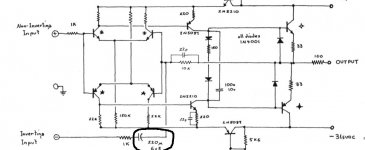I'm cautious to second guess Bryston, but I'm looking at the electrolytic caps in the feedback look and wondering if it wouldn't be a good idea to replace them with non-polarized Nichicon Muse. The input topology of the 1B preamp and 4B amp (schematics below, caps circled) is the same, and I have measured a couple of millivolts across the cap in the preamp so there's really no bias across them. These caps are approaching 30 years old and in the signal path, so they're going to get replaced anyway, so now is the time to make the change. Is this a smart move?
Jim
Jim
Attachments
Yes, the NP electrolitic capacitors work best and have less distortion that the polarized. You can see in the work of Cyril Bateman and in the book of Bob Cordell:
http://web.archive.org/web/20091027...s.com/cyrilb2@btinternet.com/downloads_5.html
Regards
http://web.archive.org/web/20091027...s.com/cyrilb2@btinternet.com/downloads_5.html
Regards
these DC blocking capacitors in the lower leg of the NFB feedback path have virtually no DC across them and virtually no AC across them, when properly sized.
This results in virtually no distortion due to the cap being added to the -IN input of the amplifier.
In my opinion there is nothing to be gained by going to non-polarised.
However, if you want to play safe then adopt the back to back non polar solution that Bateman suggests for superlative distortion performance, almost as good as the best film caps.
This results in virtually no distortion due to the cap being added to the -IN input of the amplifier.
In my opinion there is nothing to be gained by going to non-polarised.
However, if you want to play safe then adopt the back to back non polar solution that Bateman suggests for superlative distortion performance, almost as good as the best film caps.
Absolutely a smart move. Polar electrolytics exhibit their lowest distortion profile when biased at 10-25% of their rated voltage. Nonpolar exhibits a much lower distortion profile with zero or small bias.
Here's an interesting article on capacitor distortion profiles written by an engineer that works in capacitor manufacturing. Capacitor Sound Go to page 41 for the discussion on electrolytic distortion profiles.
The results of the tests in the article I cited seem to indicate that nonpolar electrolytics are better overall for audio. The author claims that this is because nonpolars consist of essentially two anodes with no cathode. The author seems to indicate that it is the cathode that introduces the most objectionable distortions.
Speaker manyfacturers sometimes used 9 volt batteries to polarise crossover electrolytics before nonpolars became available. I have employed capacitor bias circuits for feedback capacitors before with satisfactory results. However, the article seems to indicate that even this is not a great solution, with increased distortion over a single biased electrolytic and series esr.
Common polar electrolytics were fine for older design, single rail amplifiers. This is because the capacitors were employed with a bias, and also because the distortion introduced by the capacitors was typically negligible compared to the distortion of the active circuit.
Speaker manyfacturers sometimes used 9 volt batteries to polarise crossover electrolytics before nonpolars became available. I have employed capacitor bias circuits for feedback capacitors before with satisfactory results. However, the article seems to indicate that even this is not a great solution, with increased distortion over a single biased electrolytic and series esr.
Common polar electrolytics were fine for older design, single rail amplifiers. This is because the capacitors were employed with a bias, and also because the distortion introduced by the capacitors was typically negligible compared to the distortion of the active circuit.
Thanks guys, just put Nichicon Muse bipolars on order. The reason I got started on this is that the gain of one channel seems to wander and I figured these caps should be replaced anyway and might well be the cause of the problem. I'll post the results of the change after I get a chance to install and listen.
Jim
Jim
My personal experience with repairing old amps and receivers is that if the gain and distortion seem to change, it is the feedback network electrolytic capacitor. They will typically be intermittent and malfunction will be temperature dependent, so it is good policy to change them if you're working on it anyway.
Got the caps in this weekend. Still had the balance issue, so I replaced the volume pot with a $4 radio shack special, and that seems to taken care of the wandering gain. Might consider an upgrade to that later.
The preamp sounds significantly better than it did before the work. Good detail, big soundstage, I'm really impressed. It might be that the thirty year old electrolytics weren't quite what they used to be, but as $1.56 (for all six caps) mods go, this was a winner.
Jim
The preamp sounds significantly better than it did before the work. Good detail, big soundstage, I'm really impressed. It might be that the thirty year old electrolytics weren't quite what they used to be, but as $1.56 (for all six caps) mods go, this was a winner.
Jim
I have a 1b and was wondering about a recap. did you replace many or just the couple you talk about above? Thanks for any insight.
Brian
Brian
- Status
- Not open for further replies.
- Home
- Amplifiers
- Solid State
- Non-Polarized Cap in Bryston Feedback Loop?

